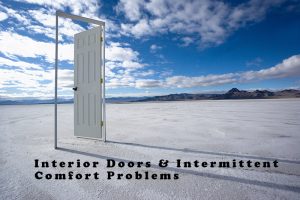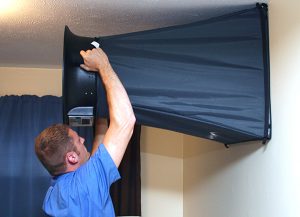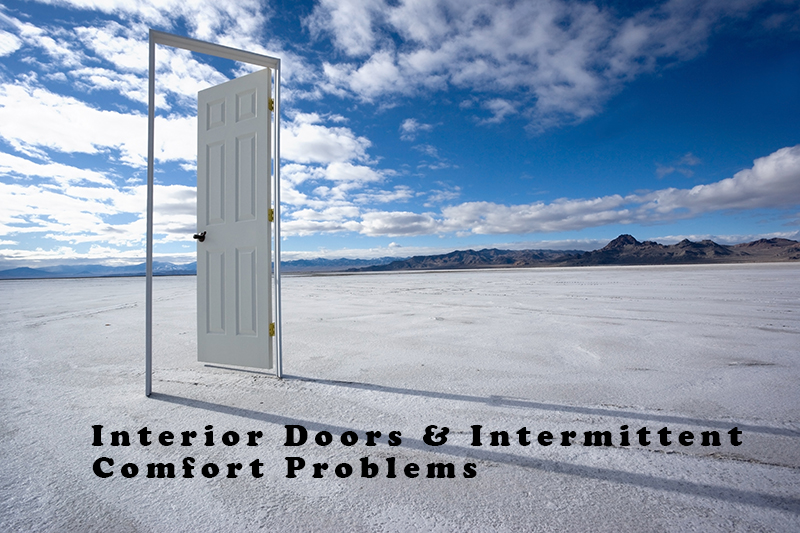
David Richardson is a Curriculum Developer & Instructor for National Comfort Institute, Inc.
This cooling season, HVAC professionals across the country will be called upon to solve intermittent comfort problems they can’t recreate. These frustrating and random problems often involve uncomfortable rooms, increases in humidity, uncontrollable dust, and odd smells. From a Performance-based Contracting perspective, let’s look at how the position of interior doors could be contributing to these intermittent problems and how you can solve them.
Interior Doors Are Dampers that Can Cause problems
Interior doors act like manual dampers in a duct system. They control how airflow moves through a home as their positions are changed from open to closed. Their position directly affects how air moves from supply registers back to return grilles located in other rooms.
In a recent private training session we held, students measured supply register airflow into a problem bedroom with a balancing hood. After we investigated further, we found the comfort problem in this room only appeared in the evening when the door was closed. We took airflow measurements with the room door open and closed to see how much of a difference the door had on supply airflow.
Here’s what we found: When the door was open, supply airflow from the register was 171 cfm; close to the amount of air needed from our calculations. We closed the door and took supply airflow readings again. To everyone’s surprise, airflow from the register dropped to 143 cfm — almost 30 cfm less. The light bulbs came on for the class. The influence of door position became visible with the balancing hood.

Interior doors act like manual dampers in a duct system.
Central Return Installations
Central return systems are typically found in ceiling, sidewall, or floor grille applications. These installations often have an extensive supply duct system with a supply register or two placed in each room. When interior doors are closed to rooms with supply registers, a competition for airflow begins.
When you close interior doors, the main area of the home, where the central return is located,’ depressurizes. In the summer, this depressurizing effect directly links to rising indoor humidity levels. Moist air from outdoors is pulled indoors and forced to mix with conditioned air. This can overwhelm the system to a point where it cannot remove moisture from the home.
Rooms with closed interior doors become pressurized. This restricts the supply airflow path back to the central return. In other words, when doors close, supply airflow to each room decreases just as if you closed a manual damper in a duct system. If you have any complaints of intermittent comfort problems and you have this type of installation, look for this interaction.
Air Balance Problems

Doors can actually cause both pressurization and depressurization of a home. The only way to know for sure is to measure airflow and balance the supply and returns in each room.
Similar issues can appear in systems having a supply and return in each room when airflow is out of balance. This problem is minimized when the interior door is opened but amplifies as the door is closed. Once the door is closed, the room is isolated from the rest of the home. The greatest amount of airflow into or out of the room will control its pressure.
When return airflow is greatest, room pressure will be negative. Why? Because more return air is pulled from the room than supplied to it. Typical complaints in this situation include increases in humidity and dust.
When supply airflow is greatest, room pressure will be positive. This means more supply air is delivered into the room than returned. This can create waste by forcing conditioned air outside the home.
Solving Pressure and Airflow Imbalance Problems
Contrary to popular belief, undercutting interior doors an inch won’t solve this airflow battle. In some situations, the door undercut would need to be the equivalent size of a saloon style door to work correctly.
Another option is to use jumper ducts and transfer grilles with central returns. This repair connects problem rooms to a central return area to relieve room pressure with closed doors. This installation depends on air naturally leaving a room for pressure relief. Building leakage can act as unintentional jumper ducts also, so do your homework and inspect first.
The best repair would be properly sized and balanced duct supplies and returns to each room. Each has dampers to adjust airflow to each room. This repair allows neutral room pressures with closed doors to assure proper airflow. In many homes this isn’t a viable option, so do the best you can with what you have.
In the end, it’s about controlling airflow. Unless your solution involves the measurement of airflow and pressure, you’ll be guessing whether the repair really worked or not.





![High Performance Contracting: Summit 2018 Panel Discussion on Implementation [PART 1]](https://hvactoday.com/wp-content/uploads/2018/06/DSC_0613-Panel-Discussion-4c3-440x264.jpg)







Recent Comments